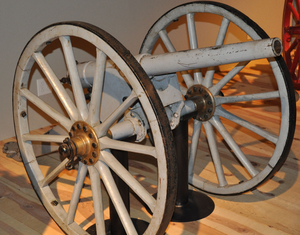M1875 Mountain Gun
| M1875 mountain gun | |
|---|---|

|
|
| Type | Mountain gun |
| Service history | |
| In service | 1875–1905? |
| Used by | |
| Wars |
American Indian Wars Spanish–American War Philippine–American War |
| Specifications | |
| Weight | 336 pounds (152 kg) |
|
|
|
| Caliber | 1.65 inches (42 mm) |
| Carriage | pole trail |
| Traverse | 0° |
| Maximum firing range | 4,000 yards (3,658 m) |
The M1875 mountain gun was a mountain gun that was used by the United States Army during the last quarter of the nineteenth Century.
A Hotchkiss design, "it was the first original breech-loading gun in the U.S. Army". It replaced the M1841 mountain howitzer in U.S. Army service. It served with cavalry units during the late American Indian Wars, including the Wounded Knee Massacre, and was used during the Spanish–American War and Philippine–American War.
It broke down into two loads for mule transport. Another mule was required for its ammunition.
A 1878 Ordnance Report from Brigadier-General Steven Vincent Benet, narrates part of the history of this gun, stating.
"Early in 1876, Colonel Miles, Fifth Infantry, suggested that a light field-gun weighing less than 500 pounds be provided for service on the plains, to replace the obsolete mountain howitzer. The subject was submitted to the Ordnance Board for consideration, with the remark “that a rifled gun, probably a breech-loader, that can travel with cavalry, and has an effective shell range beyond that of rifled small arms, not less than 1,500 yards, would probably meet the requirements of the service”. While under consideration, Mr. B.B. Hotchkiss presented for examination and trial a light breech-loading rifle that gave promise of efficient service on the frontier, and fulfill the conditions of mobility, range, and accuracy. One was procured, and issued to the Department of Dakota in 1877, and was used in the field that summer. It weighs 116lbs, and its caliber is 1.65 inches. It uses a charge of 6 ounces of powder, and a percussion shell weighing 2 pounds. While many defects in its mechanism, and in the carriage and ammunition, have been pointed out after the experience of a campaign, showing that modifications are desirable to add to its effectiveness, it did excellent work. I am informed that Colonel Miles expressed himself satisfied that it had rendered efficient service, and was a valuable weapon. With all its defects, others have been called for, and the five now in possession of the department will be issued to the troops."
...
Wikipedia
